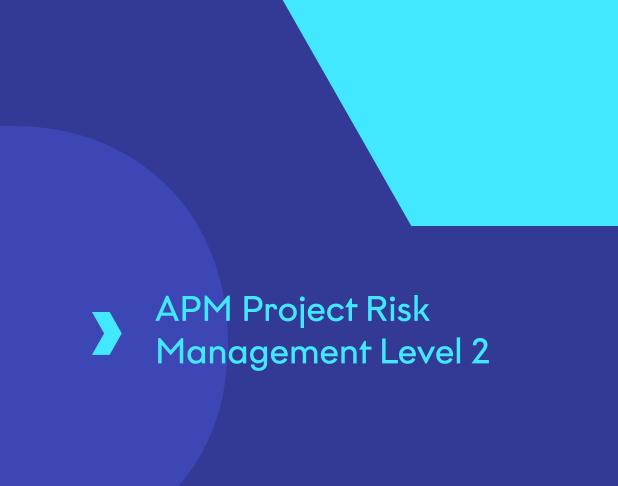The APM Project Risk Management Level 2 course increases your understanding of advanced risk management principles, techniques, and processes. It builds on foundational knowledge to equip you with the practical skills needed to identify, assess, and respond to risks effectively, enabling greater success in project delivery.
15% off eLearning, up to 20% off virtual courses - use code: NSWOCT25USA
APM Project Risk Management Level 2
Select your learning method

Advanced Risk Management Training
This four-day course equips professionals with the skills and knowledge needed to excel in advanced project risk management. Through a combination of guided learning and independent study, participants will build their understanding and practical application of risk management principles.
- Explain the benefits and principles of risk management
- Demonstrate the PRAM process
- Conduct risk identification and assessment
- Develop risk response strategies
- Use quantitative and qualitative risk assessment techniques
- Create and manage a risk register
- Apply lessons learned to future projects
What you’ll learn
This course provides comprehensive training in project risk management, focusing on advanced techniques and practical applications. It prepares you to handle risk systematically, using proven methodologies to enhance project outcomes and drive organisational success. By mastering these skills, you'll be ready to take on the APM Risk 2 exam confidently.
Understanding risk management
Discover the principles of risk management, including the dual nature of risk as both a threat and an opportunity. Learn to differentiate between risk events and project risk, and explore the benefits of a proactive risk management approach. The course also covers common challenges to effective risk management and strategies to overcome them.
Risk management processes and techniques
Master the PRAM (Project Risk Analysis and Management) process, including scaling practices for different projects. You’ll also delve into risk identification techniques, such as brainstorming and root cause analysis, and evaluate their advantages and limitations. Learn to apply these methods through practical exercises to ensure you can effectively address risks in diverse scenarios.
Risk assessment methodologies
Understand the differences between qualitative and quantitative risk assessments and when to apply each. Learn to use tools including probability grids, Monte Carlo analysis, decision trees, and sensitivity analysis. This course also equips you to assess risks comprehensively, prioritise them, and make data-driven decisions to support project objectives.
Planning and responding to risks
Learn to create actionable risk response plans tailored to specific project challenges. Explore strategies for managing threats and opportunities, assigning risk ownership, and conducting cost-benefit analyses. The course also highlights the importance of ongoing risk reviews and contingency planning to maintain control throughout the project lifecycle.
Integrating human factors and applying risk management
Gain insights into how human behaviour, such as individual attitudes and group dynamics, influences risk management. Develop strategies to mitigate these factors for more effective outcomes. You’ll also explore practical methods to introduce risk management into projects and secure senior management buy-in, ensuring its successful integration into your workflows.
- APM Risk 2 accredited training
- APM Risk 2 exam
- Online pre-course
- 40+ hours of ILX learning resources
- Tutor support
Key facts
APM Project Risk Management Level 2.
Experienced project professionals – Project Managers, Programme Managers and key project staff involved in risk management.
All delegates need to take an online assessment to determine their suitability and readiness. Please watch the APM Learner Suitability video before completing the assessment. More info in the FAQs.
Three-hour and 15-minute open-book exam with three questions (one compulsory, two from a selection of four).
The official manual (APM Project Risk Analysis and Management Guide, 2nd edition)
Mandatory online pre-course if you select classroom or live virtual classroom study options. The official manual (APM Project Risk Analysis and Management Guide, 2nd edition)
FAQs
The APM Project Risk Management Level 2 course provides advanced training in risk management concepts and techniques to prepare for certification.
Is the APM Project Risk Management Level 2 course right for me?
This course is ideal for project and programme managers, and team members responsible for risk management. You can take Risk Level 2 without completing Level 1, but it’s important to have a solid understanding of project risk management at the Level 1 standard. The exam assumes you’re familiar with the knowledge outlined in the APM Project Management Qualification syllabus. It’s also expected that you’ve read the Project Risk Analysis and Management (PRAM) Guide, 2nd Edition to prepare effectively.
What is the format of the APM Project Risk Management Level 2 exam?
The APM suggests dedicating approximately 75 hours to prepare for the APM Risk 2 exam. This includes around five hours of pre-course work, attendance at a four-day live virtual or in-person classroom course, and completion of 40 hours of additional learning resources to support your exam preparation. It’s important to ensure all learning is completed before sitting the exam.
What are the study options for this course?
You can choose between live virtual classroom and in-person classroom study options. Both include five hours of online pre-course work, attendance at a 4-day workshop, and 40 hours of additional learning resources that will help to support your exam preparation.
Why should I take the APM Project Risk Management Level 2 course?
The APM Project Risk Management Level 2 course enhances your expertise in advanced risk management, equipping you with practical tools to manage complex risks, improve project outcomes, and boost career prospects while demonstrating commitment to best practices and industry standards.

“Awesome teacher who made the content fun to learn and easy to retain.
I thought the tutor was great. They were professional with great and interesting explanations, and they made learning the course content fun. The teaching prepared me well for the exams.”

"Friendly staff who helped me with all my questions and request very quickly."
Join the half a million learners developing their skills with our training
A trusted partner to thousands of organisations worldwide
Our passionate team goes above and beyond to support customer needs
Please complete the form to ensure your quote is accurate and we will contact you soon.